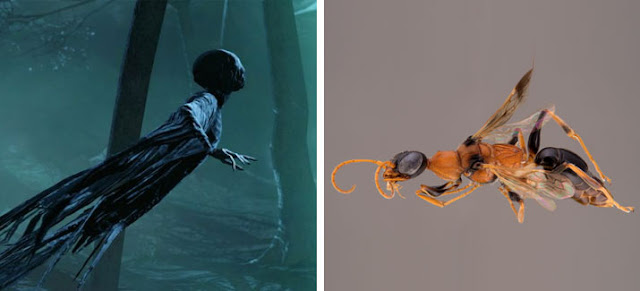Greetings everybody,
TGIF! It has been one of those weeks for me guys. It is officially exam season for mock GCSE's, real GCSE's and A-levels meaning that as a tutor I am a very busy bee! Its okay though because it is my favourite day- its blog day. I have an interesting one for you guys today. We are going to take a look at Mother Natures dark side, those hidden secrets not seen in nature documentaries often. Enjoy.
Golden poison-dart frog:
 |
| Image Source |
What a golden cutie! Meet the frog that produces the most deadliest poison of any recorded animal. This deadly poison is located on the skin of the frog. In the case of our golden poison-dart frog, size does not matter. These frogs are around 5.5 cm long and have enough poison to kill 10 grown men.
The toxins specific name is Batrachotoxin. Once inside the body it causes severe irreversible damage to an animals brain and muscles. This commonly leads to high blood pressure, seizures, respiratory paralysis and finally death. Even when exposure to this toxin is minimal!
Deadly dynamic duos:
It may be safe to assume that we all look at larvae and think 'gross'. Perhaps after learning about their slow and horrible death we can all feel a sympathy for them.
It all starts with a nematode (a type of ringworm) on the lookout for its next victim. A grub or larvae. Once located the nematode invades the larva through its breathing hole or by using its tooth to burrow inside. As it reaches the inside of the larvae it sets loose an army of bacteria from its own gut. These bacteria begin to produce toxins, digestive enzymes and even antibiotics!
The image below, shows a larvae that appears to be glowing.This light show is down to the presence of luminescent bacteria inside the grub, slowly digesting it from the inside out! There you have it the glow of inevitable death. Lastly, (as if this life cycle was not weird enough already) the nematodes then consume both the bacteria and the corpses remains! These two then go on elsewhere to do it all over again.
 |
| Image Source |
This is a perfect, yet grim example of interdependent parasitic partnerships. The nematode provides the transport link between one meal and the next. The bacteria in the gut are needed to aid in the digestion of the meal. A mutual partnership built on the cruel death of grub and larvae.
The butcher bird:
 |
| Image Source |
Commonly known as the Grey Shrike, and seen in Britain in various seasons. For the birdwatcher inside you, it is easy to find where these birds rest, all you have to look for is a series of impaled victims on either a horned tree or barbed wire! The latin for this beautiful bird is Lanius excubitor meaning the butcher sentinel. This provides a subtle hint into the bird predatory nature of the bird.
This little bird will be seen perching itself on high vantage points. Prey items for this butchering bird are small mammals birds and the occasional lizard. Once captured, the prey are carried to a thorned tree or barbed wire and then... impale it. Once skewered, the shrike with tear it to pieces with its razor sharp beak. Any remains are left as little horror decorations.
 |
| Image Source |
If you thought this bird could not get any scarier or deceptive- your wrong. Grey Shrikes have picked up the ability to mimic their preys calls. I know! How devious. Shrikes lure their prey in by mimicking their calls and then... they pounce.
The assassin bugs:
 |
| Image Source |
Clue is in the name, these are pretty badass bugs. Assassin bugs impale their victims by spearing them with their needle-like mouthparts. Once speared the victims body is filled with paralytics and digestive juices. Paralytics stop the prey from escaping, whereas the digestive juices do the job of liquifying the organs and turning them into a high protein slushy. This is then sucked up by the bug! Eww
Acanthaspis petax, has an extremely special ritual for their kills. Their favourite prey item are ants. This assassin bug makes its armour out of the dead bodies of ants! Pretty extreme.
Feather legged assassin bugs, produce an irresistible substance to lure ants to them. When the ants lick this secretion they become paralysed. Doomed to their fate. The assassin pierces the ants cavity and sucks up all bodily organs. Lovely.
The Dementorwasp:
 |
| Image Source |
I know what you're thinking. This cannot possibly be real? But it is. This particular species gained its name through a public vote. A publicity stunt to get the public more engaged with classification and biodiversity. After learning about the predatory behaviours of this little wasp, Dementorwasp was chosen.
Like all wasps, they carry a sting. Dementorwasps use theirs to inject a cocktail of neurotoxins directly into the brain of a cockroach. Once injected the neurotoxins get straight to work, by enslaving the roach to the wasps will.
In its docile state the roach is lead to the wasps nursery. Once settled in nicely the wasp lays her eggs on the inside of the roach. The inside of a roach may seem like an awful place to lay a child, but the wasp larvae benefit from an abundance of food. Provided for by the roach. Alive. What an awful fate! Does the cockroach feel these things growing and digesting it from the inside?
Alright folks. That was your biobunch fix for the day. Of course if you find yourself itching for more please dive into any one of the 98 other posts on this beautiful blog. Today was a bit gruesome! But hay. Nature is not all roses and sunshine... there is a sinister side to it to.
Hope you enjoyed it, as always I did.
Biobunch,
Over and out




























